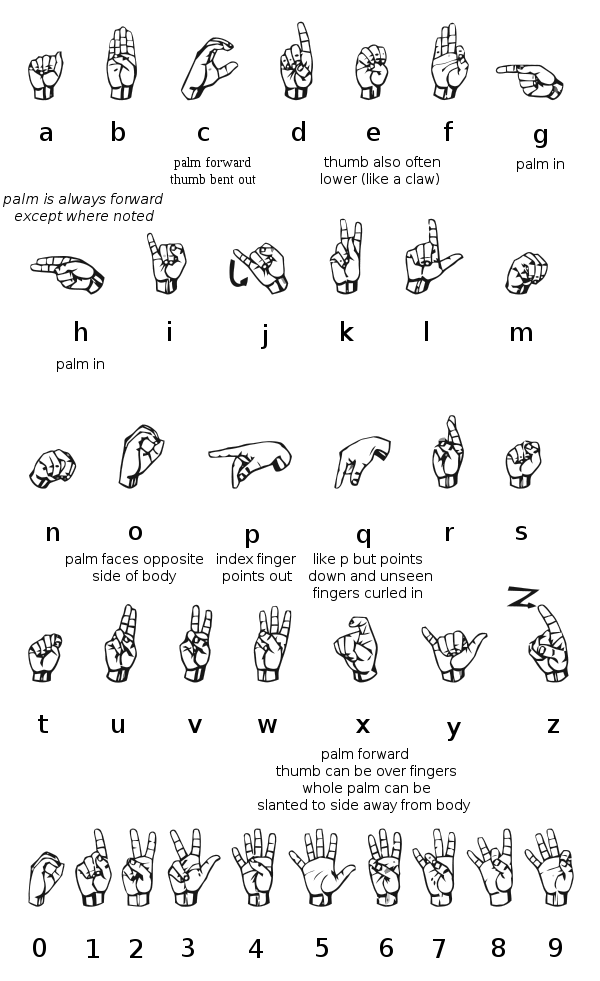Difference between revisions of "AY Honors/Sign Language/Answer Key"
| Line 59: | Line 59: | ||
===Graphically=== | ===Graphically=== | ||
| − | {{ | + | {{Manual_letters|F|I|N|A|L|L|Y}} |
| − | {{ | + | {{Manual_letters|B|R|O|T|H|E|R|S}} |
| − | {{ | + | {{Manual_letters|W|H|A|T|E|V|E|R|}} |
| − | {{ | + | {{Manual_letters|I|S}} |
| − | {{ | + | {{Manual_letters|T|R|U|E}} |
| − | {{ | + | {{Manual_letters|W|H|A|T|E|V|E|R|}} |
| − | {{ | + | {{Manual_letters|I|S}} |
| − | {{ | + | {{Manual_letters|N|O|B|L|E}} |
| − | {{ | + | {{Manual_letters|W|H|A|T|E|V|E|R|}} |
| − | {{ | + | {{Manual_letters|I|S}} |
| − | {{ | + | {{Manual_letters|R|I|G|H|T}} |
| − | {{ | + | {{Manual_letters|W|H|A|T|E|V|E|R|}} |
| − | {{ | + | {{Manual_letters|I|S}} |
| − | {{ | + | {{Manual_letters|P|U|R|E}} |
| − | {{ | + | {{Manual_letters|W|H|A|T|E|V|E|R|}} |
| − | {{ | + | {{Manual_letters|I|S}} |
| − | {{ | + | {{Manual_letters|L|O|V|E|L|Y}} |
| − | {{ | + | {{Manual_letters|W|H|A|T|E|V|E|R|}} |
| − | {{ | + | {{Manual_letters|I|S}} |
| − | {{ | + | {{Manual_letters|A|D|M|I|R|A|B|L|E}} |
==4. Learn at least 100 signs from one or more of the below referenced books.== | ==4. Learn at least 100 signs from one or more of the below referenced books.== | ||
Revision as of 17:09, 14 October 2008
1. Learn the manual alphabet used by the deaf.
The American Manual Alphabet is a manual alphabet that augments the vocabulary of American Sign Language when spelling individual letters of a word is the preferred or only option, such as with proper names or the titles of works. Letters should be signed with the dominant hand and in most cases, with palm facing the viewer.
Chart
The ASL alphabet is based on an old Spanish manual alphabet that dates back to at least the seventeenth century.
It is used with minor modification in Paraguay, the Philippines, Thailand, Malaysia, Hong Kong, Taiwan, and Singapore. The Asian countries just listed modify the T, for the ASL T is considered obscene. Instead, they use the T of the Irish manual alphabet, which is like an ASL X, but with the thumb tucked into the index finger (that is, the index finger wraps around the tip of the thumb). In Thailand, one indicates points on the left hand for the tone and vowel marks of the Thai alphabet, and aspiration is not indicated. The Paraguay alphabet is identical to ASL, except for the addition of the letter Ñ, which is an N swiveled at the wrist so that the fingers move side to side, and the letters LL and RR, which are L and R plus movement to the side.
It is also used in Germany, Austria, Norway, and Finland, again with a modification for the letter T. T is like G with the thumb placed atop the first knuckle of the index finger.
German Ä, Ö, Ü, and ß are signed like A, O, U, and S but with a downward motion, while SCH is a 5 hand (palm forward). In Norwegian and Finnish, the letters Ä, Å, Ö, Ø are derived by moving A and O (in the case of Å, in a small window-washing circular motion), and it is the Æ that gets the 5 hand (perhaps somewhat flexed).
Good form
- The hand should either remain in place while fingerspelling, or more often, drift slightly away from the midline in the manner of text being written out in the air; although, this is a subtle movement and should not be exaggerated.
- If fingerspelling multiple words or entire sentences, there should be a very brief pause between terms so as to signify the beginning and ending of individual words.
- Long nails or excessive jewelry can be distracting when watching fingerspelling and for this reason people who regularly use sign language usually avoid them.
- When fingerspelling acronyms in American Sign Language, such as with FBI, NASA, or RID (Registry of Interpreters for the Deaf), the letters are often moved in a small circle to emphasize that they should not be read together as a word.
- Additionally, when fingerspelling the hand should not bounce between letters. An exception is the case of double letters as with the word carry in which the double R can be shown by slightly bouncing the corresponding handshape, or by dragging it, slightly, to the side. Either method is a correct way to show double letters. However, people who bounce between every letter produce fingerspelling that is very hard to watch or understand. Those who cannot overcome the habit of bouncing every letter may find it helpful to hold the wrist of the hand doing the fingerspelling with the free hand so that they are forced to keep the hand from moving up and down while fingerspelling. Usually, only a few hours or days of this is enough to break the habit of unnecessary bouncing while fingerspelling.
Common mistakes
Many mistakes made by beginning fingerspellers are directly attributable to how the manual alphabet is most often shown in graphics.
Letters
In most drawings or illustrations of the American Manual Alphabet, some of the letters are depicted from the side to better illustrate the desired handshape; however in practice, the hand should not be turned to the side when producing the letter. The letters C and O are two that are often mistakenly turned to the side by beginners who become used to seeing them from the side in illustrations. Important exceptions to the rule that the palm should always be facing the viewer are the letters G and H. These two letters should be made, not with the palm facing the viewer or the speaker, but with the palm facing sideways - the hand in an ergonomically neutral position.
Numbers
Another mistake made by people faithfully following the pictures in most illustrations of the ASL fingerspelling alphabet is the signing of the cardinal numbers 1 - 5 with the palm facing out. The cardinal numbers 1, 2, 3, 4, and 5 should be signed palm in (towards the signer). This is in contrast with the cardinal numbers 6-9 which should be produced with the palm turned to face the person being addressed.
As with the letter O, the zero should not be turned to the side, but shown palm facing forward.
This applies only to the cardinal numbers however. Using numbers in other situations, such as with for showing the digits of the time for example, has different rules. When signing the time, the numbers are always facing the person being addressed, even the numbers one through five. Other signing situations involving numbers have their own norms that must be learned on a case by case basis.
Rhythm, speed & movement
When fingerspelling, your hand should be at shoulder height, and should not 'bounce' with each letter. Your hand should stay in one place and only the handshape changes (and orientation for some letters). If you have trouble doing this, you might want to hold your forearm with your nondominant hand in order to force your spelling hand to stay still. 'Bouncing' the letters makes your fingerspelling difficult to read, even for native signers.
As well, clear handshapes are much easier to read than fast fingerspelling. Do not concentrate on speed, as fast fingerspelling with poorly formed handshapes will be difficult to read. Try to fingerspell the whole word at the same speed, not speeding up or slowing down. A pause indicates the beginning of a new word, so if you suddenly slow down because a letter combination is difficult, your reader may think you are starting a new word, leading to misunderstanding. An exception to this sometimes appears at the beginning of a word. The first letter may be held for the length of a letter extra as a cue that the signer is about to start fingerspelling.
2. Have a minimum of three hours of instruction in signing.
Have fun. You will learn a lot if you focus.
3. Send and receive finger spelling at the rate of five words per minute using a minimum of 25 letters.
Tips
When you are first learning to sign the letters, a good Bible text to practice with is Philippians 4:8, as it repeats the phrase "whatever is" several times. Since it is so repetitive, You should be able to quickly signal the "whatever is" portion to get your speed up. This verse contains all the letters of the alphabet except j, q, and z which can be learned afterwards. Learning a text such as this will also force you to learn each letter on its own (as opposed to always signing K after J). Once a text such as this one has been learned you may be surprised that you can finger spell just about anything.
Finally, brothers, whatever is true, whatever is noble, whatever is right, whatever is pure, whatever is lovely, whatever is admirable—if anything is excellent or praiseworthy—think about such things.
Graphically

|

|

|

|

|

|

|

|

|

|

|

|

|

|

|
| F | I | N | A | L | L | Y |

|

|

|

|

|

|

|

|

|

|

|

|

| ||
| B | R | O | T | H | E | R | S |

|

|

|

|

|

|

|

|

|

|

|

|

|

| |
| W | H | A | T | E | V | E | R |

|

|

|

|

|

|

|

|

|

|

|

|

|

|

|
| I | S |

|

|

|

|

|

|

|

|

|

|

|

|

|

|

|
| T | R | U | E |

|

|

|

|

|

|

|

|

|

|

|

|

|

| |
| W | H | A | T | E | V | E | R |

|

|

|

|

|

|

|

|

|

|

|

|

|

|

|
| I | S |

|

|

|

|

|

|

|

|

|

|

|

|

|

| |
| N | O | B | L | E |

|

|

|

|

|

|

|

|

|

|

|

|

|

| |
| W | H | A | T | E | V | E | R |

|

|

|

|

|

|

|

|

|

|

|

|

|

|

|
| I | S |

|

|

|

|

|

|

|

|

|

|

|

|

| ||
| R | I | G | H | T |

|

|

|

|

|

|

|

|

|

|

|

|

|

| |
| W | H | A | T | E | V | E | R |

|

|

|

|

|

|

|

|

|

|

|

|

|

|

|
| I | S |

|

|

|

|

|

|

|

|

|

|

|

|

|

| |
| P | U | R | E |

|

|

|

|

|

|

|

|

|

|

|

|

|

| |
| W | H | A | T | E | V | E | R |

|

|

|

|

|

|

|

|

|

|

|

|

|

|

|
| I | S |

|

|

|

|

|

|

|

|

|

|

|

|

|

|

|
| L | O | V | E | L | Y |

|

|

|

|

|

|

|

|

|

|

|

|

|

| |
| W | H | A | T | E | V | E | R |

|

|

|

|

|

|

|

|

|

|

|

|

|

|

|
| I | S |

|

|

|

|

|

|

|

|

|

|

|

|

| ||
| A | D | M | I | R | A | B | L | E |
4. Learn at least 100 signs from one or more of the below referenced books.
- A Basic Course in Manual Communication, T.J. O'Rourke, National Association of the Deaf, 814 Thayer Avenue, Silver Spring, MD 20901.
- Ameslan, An Introduction to American Sign Language, Louie Fant, Jr., Joyce Media, P.O. Box 458, Northridge, CA 91328. Play It By Sign, Ibid. (Joyce Media also has instructional films.)
- Joy of Signing, Lottie, L. Riekehof, Gospel Publishing House, Springfield, MO.
- Talk to the Deaf, Etc., Gallaudet College Press, Washington, D. C. 20002.
- Expressive and Receptive Fingerspelling for Hearing Adults, La Vera M. Guillory, Claitor's Publishing Division, P.O. Box 3333, Baton Rouge, LA 70821.
- An Introduction to Manual English, The Washington State School for the Deaf, Vancouver, WA 98661.
5. Learn and present in sign language (note finger spelling) at least two simple songs.
1. Jesus Love Me, You should all know it
6. Do one of the following:
a. Explain the difference between Ameslan and signed English, and demonstrate the use of both.
Ameslan, or American Sign Language, has little connection to English grammar. This language was developed by the deaf community as an efficient and expressive method of communication. Signed English, on the other hand, was designed with a more direct connection to English grammar, the theory being that knowing it would make reading and writing in English easier. Signed English follows the same word order and syntax as spoken English, while the word order in Ameslan is conceptually-based.
b. Read and give an oral or written report on a school in your country or state specializing in deaf education.
See the Wikipedia article Schools for the Deaf for a list.
References
- The answers to requirement 1 were imported directly from the Wikipedia article American Manual Alphabet and merged into this chapter. The edit history reflects contributors from Wikipedia as well as from Wikibooks.
- http://library.thinkquest.org/11942/asl.html Difference between Ameslan and signed English

